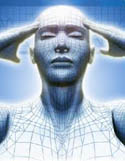How to Achieve Relaxation Through Visualization
Stress is part of everyone's daily life. When you're living with depression or bipolar disorder, the levels of stress and anxiety can quickly climb. Learning how to relax can relieve that stress and anxiety. And visualization is a great relaxation technique that can help with that.
What is Visualization?
 Visualization, seeing an object or a process and learning how to perform a specific action. The mind cannot tell the distinguishing characteristics between a real experience and one that has been vividly and repeatedly imagined. During visualization exercises, the mind can't tell the difference between a real performance and one that is imagined. Neither can the body. Most important, when you visualize yourself, you see yourself in the present, As if you would see it through your own eyes, not watching through the eyes of a spectator.
Visualization, seeing an object or a process and learning how to perform a specific action. The mind cannot tell the distinguishing characteristics between a real experience and one that has been vividly and repeatedly imagined. During visualization exercises, the mind can't tell the difference between a real performance and one that is imagined. Neither can the body. Most important, when you visualize yourself, you see yourself in the present, As if you would see it through your own eyes, not watching through the eyes of a spectator.
The first step in visualization is relaxation. One of the more common methods of relaxation is autogenic or progressive muscle relaxation training. This method involves a series of relaxation sessions. Most start with sitting in a meditative position with your palms up (yes, palms up makes a difference). Most people gently close their eyes. Then begin a process of deep breathing, exhaling to a mental count that is twice as long as you inhale. The next step is making your right arm feel heavy; then your left arm. Visit this site if you would like a more detailed description of these relaxation exercises.
Meditation for Relaxation
Another method of relaxation is meditation, simply defined as “having a steady mind.” In meditation, when your thoughts go up, you don't go up. When your thoughts go down, you don't go down. You just watch as your thoughts go up and thoughts go down. If your thoughts are good or bad, exciting or boring, you let them be. You don't accept some and reject others. Bipolar Vida blogger, Cristina Fender, uses meditation to as part of her bipolar treatment plan.
How Does Meditation Work?
In meditation, you can experience a sense of existence or being that includes your thoughts. You are not conditioned by your thoughts. There are over thirty types of meditation, some geared towards relaxation and others improving your heart or other organs of the body. Meditation is typically used for relaxation or bringing inner peace. Sometimes meditation can be used to turn negative thoughts or feelings into positive ones. If you are interested in more meditation info go here.
Now that you are starting to go into relaxation mode, we can try a visualization. The best images are from your perspective not the third-party view. Next is seeing an image with movement in it, walking, a babbling brook or birds flying. Finally think of an image you personally find calming. Follow what has been mentioned before:
- Relax through meditation or autogenic training
- Think of a calming image
- Follow the visual conditions described above
- Continue calming and imaging, you now have the basics of visualization
I, personally, think of walking through a rolling farm field while using meditation relaxation. Remember, seeing is believing and believing leads to achieving. Have you tried relaxation or visualization? Let me know what experiences you have had.
APA Reference
Zawistowski, P.
(2010, December 21). How to Achieve Relaxation Through Visualization, HealthyPlace. Retrieved
on 2026, January 1 from https://www.healthyplace.com/blogs/workandbipolarordepression/2010/12/visualization-and-learning
Author: Peter Zawistowski
Hello, i have a question or 2 for you. First off i am bi-polar 1 with savere depression. I have been trying to both meditate and use visualization for almost a month now with no luck, All i see when my eyes are closed is clouds of grey smoke swirling nothing else, i can't seem to form any pictures at all in my mind. Please help me if you can.
Dear Mr Zawistowski, although both times I could not find understanding with Your article on Relaxation, as far as practical and important, also like to add something. First of all Happy New Year, and all the best in personal and professional plan during 2011. For me the theme of anxiety remains as a primary daily activity. This is the very fact that anxiety disorders presents a challenge and an enigma to the psychiatrist, because the same causes concern, suffering and what is the main sense of dissatisfaction as well as distrust of patients to the psychiatrists. I appreciate the relaxation techniques have a great assistance in dealing with these difficult psychiatric entities.
Anxious disorders are a daily occurrence in medical practice, while in the psychiatric care system constitute the main preoccupation. Anxiolytic medication remain routine treatment of this uncomfortable concern. But these drugs have temporary effect and if used a long time harm our health. Therefore, relaxation techniques are welcome, because they are simple, harmless, inexpensive and convenient for everyone. As a general rule during relaxation, is to concentrate our mind in our body during happy experiences and pleasant places.
Anxious disorders are a daily occurrence in medical practice, while in the psychiatric service constitute the main preoccupation. Routine treatment courses achieved only by anxiolitic drugs, which in addition to temporary effects causes adverse health damage, especially in the long term treatment.
Therefore, relaxation techniques are welcome for its fact that the same are simple, harmless, inexpensive and convenient for everyone (age and social class). As a general rule during relaxation is the phenomenon of "feed back", that is realized through this pathway: body-mind body.